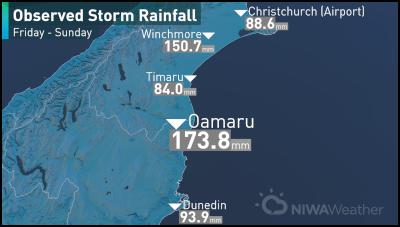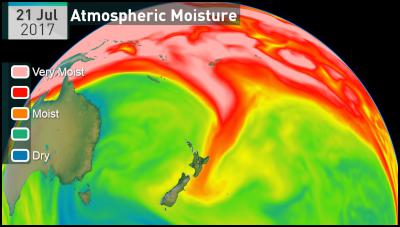Winter storm delivers wettest day on record
Winter storm delivers wettest day on record
The latest atmospheric river over
New Zealand delivered one town’s wettest day on record,
and broke several other long-held rainfall statistics,
according to NIWA data.
Lower pressure than
normal has fuelled several high impact weather events during
July.

Standout statistics
include:
• Oamaru’s
wettest day on record since daily rainfall records started
in 1950. That happened on Friday when 161.2mm was recorded
in 24 hours. The previous record was 128mm in April, 2006.
In a normal July Oamaru’s total rainfall is
40.6mm.
• Following last week’s rain, winter 2017
became Oamaru's wettest winter on record and July 2017 the
wettest July for the town on record.
• Dunedin had its
wettest July day on record since 1918 on Friday when 89mm
fell – beating the 2007 record of 75.8mm.
• At
Winchmore, South Canterbury, between 9am on
Friday and 9am on Saturday, 150.7mm of rain was recorded –
more than the twice the normal total for the whole of
July.
• Christchurch recorded 88.6 mm
at the airport. Christchurch’s normal July total rainfall
is 64.7 mm.

Atmospheric
river
Atmospheric rivers are long, narrow regions in the atmosphere—like rivers in the sky—that transport water vapour from the tropics.
Emerging research indicates that for New Zealand, atmospheric rivers occur about 40 days per year and are associated with up to 48% of rainfall extremes for parts of the country. Atmospheric rivers were also prevalent during events like the Tasman Tempest and the remnants of ex-Tropical Cyclone Debbie earlier this year.
High tides
The extreme rainfall
over the weekend coincided with some very high storm tides
for Christchurch. The peak storm tide about about 3:15 pm
on Saturday was equal highest recorded in last 13 years at
NIWA’s Sumner gauge , which exacerbated flooding in low
lying areas.
NIWA scientists were able to forecast a drop
in the next tide at 3am on Sunday but further high tides
combined with rainfall caused more flooding. Fortunately for
Timaru and Christchurch, the storm arrived just ahead of
peak king tides yesterday and today.
What’s
next
The Tasman Sea is expected to remain an active place this week, sending several fronts up the west coast of the South Island and western and upper North Island. From Thursday into Friday, a slow moving area of low pressure may bring more drenching rain to areas that have been hit hard this month, including middle and upper Canterbury and Wellington-Wairarapa. However, rainfall isn’t expected to be as heavy as the last storm.
Heading into the weekend and early next week, high pressure may arch over the country, delivering a period of dry weather for many places aside from the eastern North Island where an onshore breeze may deliver rounds of rain.


 John Mazenier: Gaffer Tape And Glue Delivering New Zealand’s Mission Critical Services
John Mazenier: Gaffer Tape And Glue Delivering New Zealand’s Mission Critical Services Earthquake Commission: Ivan Skinner Award Winner Inspired By Real-life Earthquake Experience
Earthquake Commission: Ivan Skinner Award Winner Inspired By Real-life Earthquake Experience Reserve Bank: Consultation Opens On A Digital Currency For New Zealand
Reserve Bank: Consultation Opens On A Digital Currency For New Zealand NIWA: Ship Anchors May Cause Extensive And Long-lasting Damage To The Seafloor, According To New Research
NIWA: Ship Anchors May Cause Extensive And Long-lasting Damage To The Seafloor, According To New Research New Zealand Customs Service: A Step Forward For Simpler Trade Between New Zealand And Singapore
New Zealand Customs Service: A Step Forward For Simpler Trade Between New Zealand And Singapore Horizon Research: 68% Say Make Banks Offer Fraud Protection
Horizon Research: 68% Say Make Banks Offer Fraud Protection



